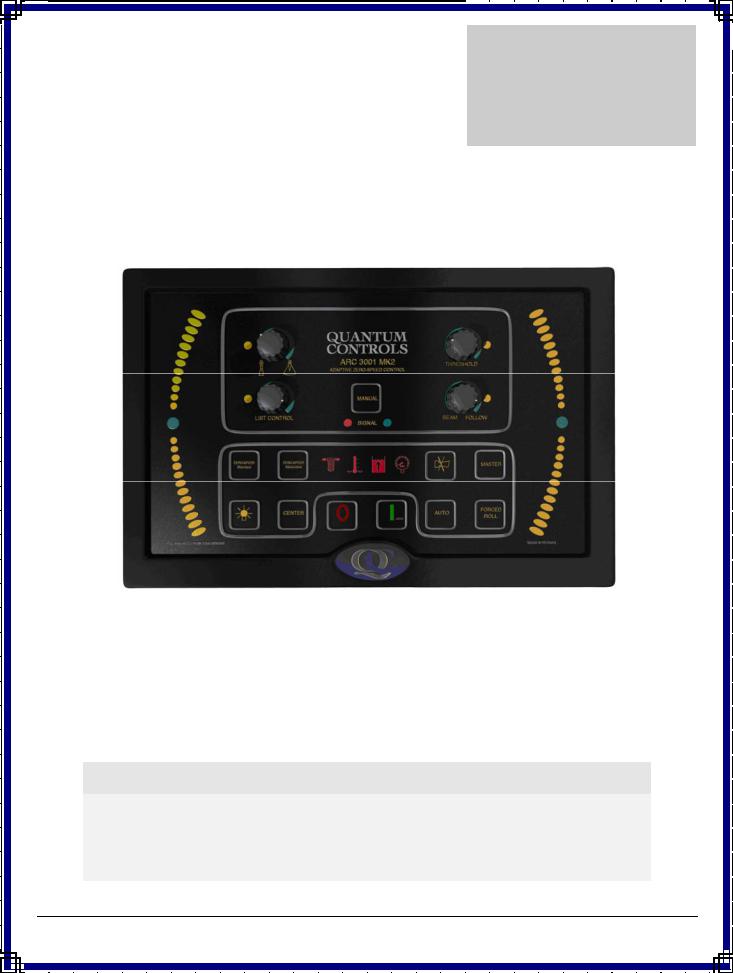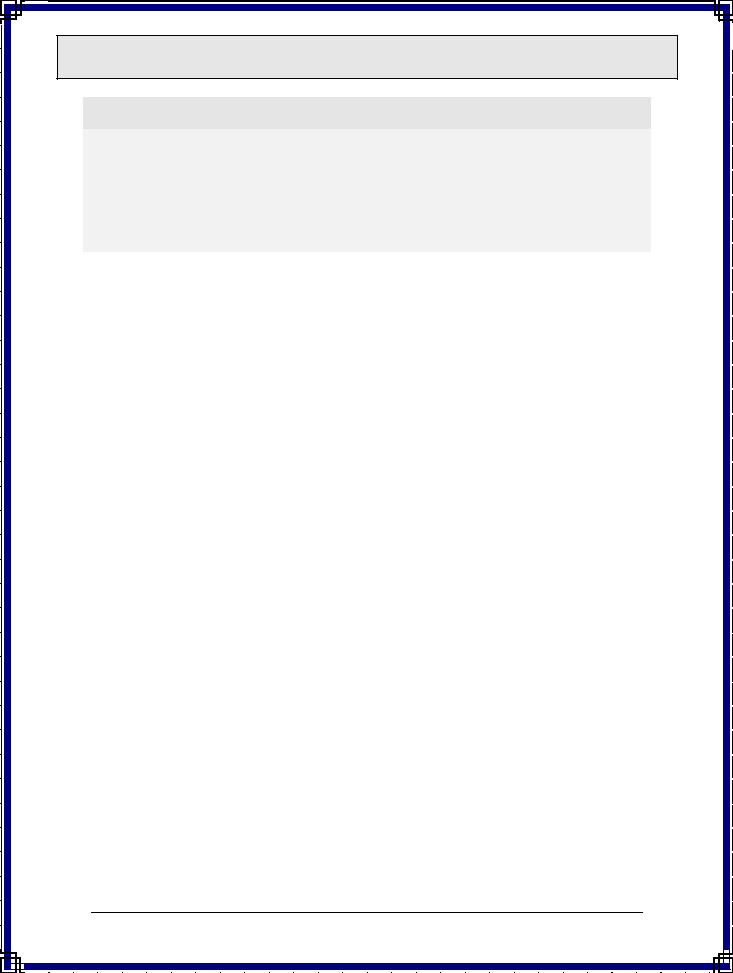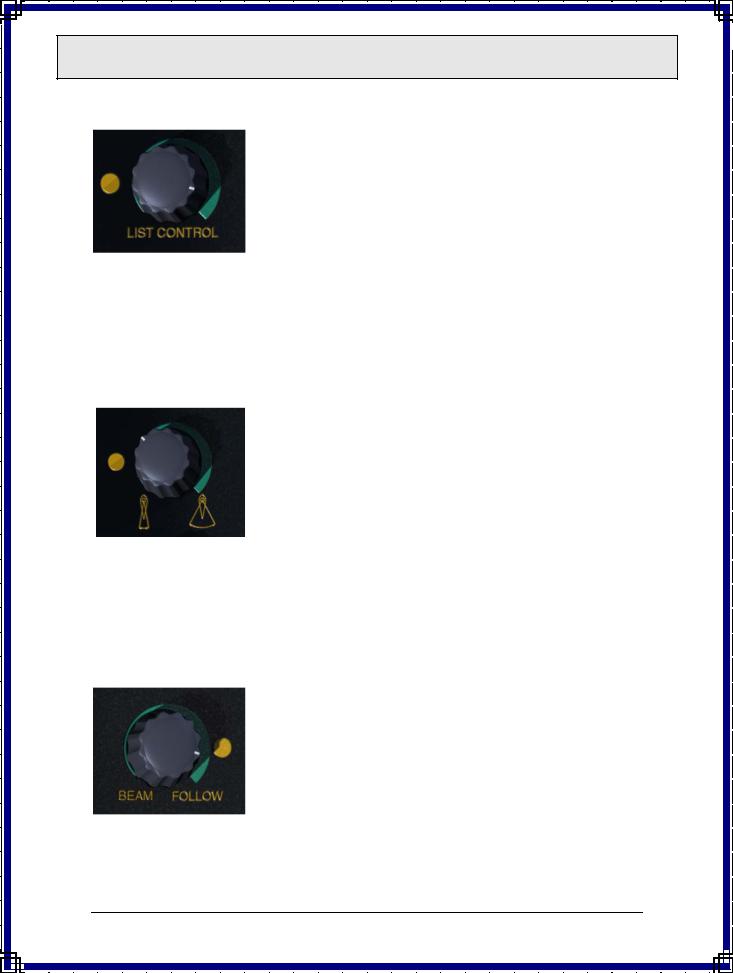ARC 3001 MK2 Operation

A R C 3 0 0 1 M K 2
O P E R A T I O N S U M M A R Y
ARC
3001MK2
ARC 3001 MK2 OPERATION SUMMARY
System Startup
To start the ARC-3001 MK2 it is first necessary to press and hold the
(I)+TEST button until an audible beep is heard (approximately one second).
The unit will first go into a test mode, which lasts approximately twenty seconds. After the test program has been completed it will automatically switch to the center position.
Note
When the power unit controls are set to auto the initialization of the ARC-3001 will automatically start the power unit. After starting the ARC-3001, verification that the power unit is running should be made.
|
|
0 6 1 0 1 0 |
Quantum |
|
|
|
||
|
|
|
|
|
||||
|
|
|
|
1 |
|
|
|
|
|
|
|
|
|
|
|
|
|
|
|
|
|
|
|
|
|
|
|
|
|
|
|
|
|
|
|
|
|
|
|
|
|
|
|
|

A R C 3 0 0 1 M K 2
O P E R A T I O N S U M M A R Y
0Caution:
When the vessel is underway or maneuvering, the system should be active. In the case of maneuvering, the system should be in center. If it is not possible to activate the system, then the manual centering system should be engaged. Under no circumstances should the system be left inactive or with the manual centering system disengaged when the vessel is underway or maneuvering.
Active operation of the Quantum Controls ARC-3001 MK2 stabilizer system can be divided into four parts:
1.The Automatic Mode (Underway)
2.The Manual Mode (Underway)
3.Zero-Speed Standard Mode
4.Zero-Speed Modulated Mode
1. Automatic Mode (Underway)
After the system startup has been completed it is possible to select the desired mode of operation. If the Auto mode is selected there is no further adjustment required. For most sea conditions the Auto mode should be the first choice, as it will constantly update the operating parameters for best results.
2. Manual Mode (Underway)
In severe or unpredictable sea conditions it may be desirable to utilize the manual mode. A typical example of this is given below:
In severe stern or following seas the Auto mode will try to reduce the roll. However, it is hesitant to use the full fin travel all the time as this could result in cavitation around the fins, with the attendant noise problems. In such a case one could decide that some cavitation noise is a small price to pay for reduced rolling. It has also been found that in very light or flat sea conditions the use of manual mode can be advantageous as it allows the operator to reduce the system gain and soften the ride of the vessel. The manual mode also allows the adjustment of the natural list control. In certain conditions it may be desirable to reduce or increase the amount of natural list correction.
After pressing the Manual button, three of the rotary controls will be available for trimming the system for best performance. The LED next to the active control will light up.
|
|
0 6 1 0 1 0 |
Quantum |
|
|
|
||
|
|
|
|
|
||||
|
|
|
|
2 |
|
|
|
|
|
|
|
|
|
|
|
|
|
|
|
|
|
|
|
|
|
|
|
|
|
|
|
|
|
|
|
|
|
|
|
|
|
|
|
|
|
|
|
|
|
|
|
|
|

A R C 3 0 0 1 M K 2
O P E R A T I O N S U M M A R Y
Lower Left: (NATURAL) LIST CONTROL
Every vessel from time to time will encounter a natural list due to such factors as wind heal or loading conditions. The system can automatically correct this by means of placing the fins at an offset angle from their neutral plane, thus inducing a constant lift force to maintain the correct attitude.
It is important to understand that offsetting the fins will add extra resistance through the water. For long passages it is better to leave this control in the low position. If required, make the necessary list corrections through ballasting. By increasing this control (rotating clockwise) the fin offset for a given list angle is increased.
Upper Left: FIN ANGLE DEFLECTION
The amount of fin deflection against the signal given from the roll sensor is a variable. With this control it is possible to increase or decrease the overall sensitivity of the system. At low speeds the fins need to move through larger angles than would be required at high speed to correct the roll motion. If the setting is too high, the vessel may feel stiff or under certain circumstances the control will appear to over-correct.
As most Zero-Speed systems have overly large fins to accommodate the requirements necessary to stabilize the vessel at anchor, adjustment of this control can be important to optimize the ride and feel of the vessel. It may also be desirable to reduce the gain on this control in very heavy seas to minimize loads on the fins. This is especially prevalent on four fin systems.
Lower Right: BEAM/FOLLOW
When sailing under following-sea conditions, the approaching frequencies of the waves are much lower than when sailing under beam-sea conditions. In following-seas, the system requires more signal from the angle sensor due to the low frequencies of encounter. For these conditions the control should be turned towards FOLLOW. In beam-seas the roll
velocity signal needs to have priority. For this condition the BEAM position would be more suitable.
|
|
0 6 1 0 1 0 |
Quantum |
|
|
|
||
|
|
|
|
|
||||
|
|
|
|
3 |
|
|
|
|
|
|
|
|
|
|
|
|
|
|
|
|
|
|
|
|
|
|
|
|
|
|
|
|
|
|
|
|
|
|
|
|
|
|
|
|
|
|
|
|
|
|
|
|
|
